Unit3Immoreoutgoingthanmysister全单元教案
I'm more outgoing than my sister 优秀教案
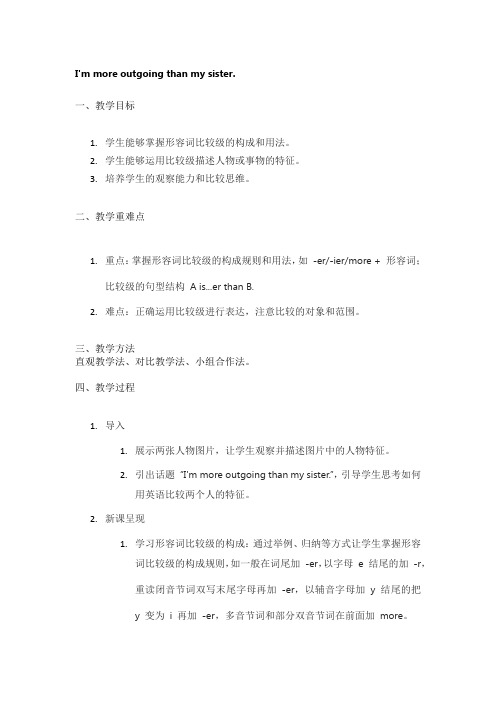
I'm more outgoing than my sister.一、教学目标1.学生能够掌握形容词比较级的构成和用法。
2.学生能够运用比较级描述人物或事物的特征。
3.培养学生的观察能力和比较思维。
二、教学重难点1.重点:掌握形容词比较级的构成规则和用法,如-er/-ier/more+形容词;比较级的句型结构A is...er than B.2.难点:正确运用比较级进行表达,注意比较的对象和范围。
三、教学方法直观教学法、对比教学法、小组合作法。
四、教学过程1.导入1.展示两张人物图片,让学生观察并描述图片中的人物特征。
2.引出话题“I'm more outgoing than my sister.”,引导学生思考如何用英语比较两个人的特征。
2.新课呈现1.学习形容词比较级的构成:通过举例、归纳等方式让学生掌握形容词比较级的构成规则,如一般在词尾加-er,以字母e结尾的加-r,重读闭音节词双写末尾字母再加-er,以辅音字母加y结尾的把y变为i再加-er,多音节词和部分双音节词在前面加more。
2.学习比较级的用法:通过例句、对话等方式让学生理解比较级的句型结构A is...er than B.,并学会运用比较级描述人物或事物的特征。
3.练习巩固1.小组活动:学生分组,互相描述自己和小组成员的特征,并使用比较级进行比较。
2.游戏环节:“找不同”,教师出示两张相似的图片,学生用比较级找出图片中的不同之处。
4.拓展延伸1.讨论个人优点和不足:引导学生思考自己的优点和不足,并与他人进行比较,学会取长补短。
2.写作练习:让学生根据自己的实际情况,写一篇关于自己和朋友的比较短文。
5.课堂总结1.回顾本节课所学的形容词比较级的构成和用法。
2.强调比较思维的重要性。
3.布置作业:用比较级描述自己的家庭成员或身边的事物。
unit3 I am more outgoing than my sister 教案
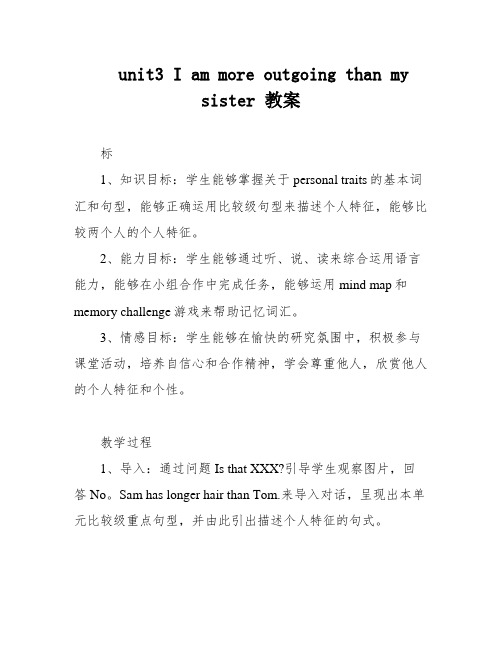
unit3 I am more outgoing than mysister 教案标1、知识目标:学生能够掌握关于personal traits的基本词汇和句型,能够正确运用比较级句型来描述个人特征,能够比较两个人的个人特征。
2、能力目标:学生能够通过听、说、读来综合运用语言能力,能够在小组合作中完成任务,能够运用mind map和memory challenge游戏来帮助记忆词汇。
3、情感目标:学生能够在愉快的研究氛围中,积极参与课堂活动,培养自信心和合作精神,学会尊重他人,欣赏他人的个人特征和个性。
教学过程1、导入:通过问题Is that XXX?引导学生观察图片,回答No。
Sam has longer hair than Tom.来导入对话,呈现出本单元比较级重点句型,并由此引出描述个人特征的句式。
2、研究活动:通过1a—1c的对话训练和听力练,以personal traits为话题研究相关的生词和基本句型。
引导学生运用mind map和memory challenge游戏来帮助记忆词汇。
3、合作探究:设计明星对比场景,帮助学生能正确选用副词及形容词和句型来谈论个人特征,并能XXX。
通过小组合作完成任务,培养学生的合作精神和自信心。
4、巩固练:设计1c的练,让学生通过听力和口语练巩固所学知识。
5、作业布置:布置课后作业,要求学生在家中运用所学内容描述自己和家人的个人特征,并写一篇短文。
本节课的教学设计遵循任务型教学理念,以学生为主体,注重学生的生活实际和生活体验,让学生在用中学,学中用。
通过多种教学活动,如游戏、小组合作等,激发学生的研究兴趣和积极性。
同时,注重培养学生的综合语言能力和合作精神,使其在研究过程中不仅学会知识,还能培养出良好的情感态度和价值观。
Teaching Focus: Comparing People's Traits and Using Comparative Adjectives and AdverbsXXX: XXX real teaching tasks.XXX: XXX courseware。
I’m more outgoing than my sister教案
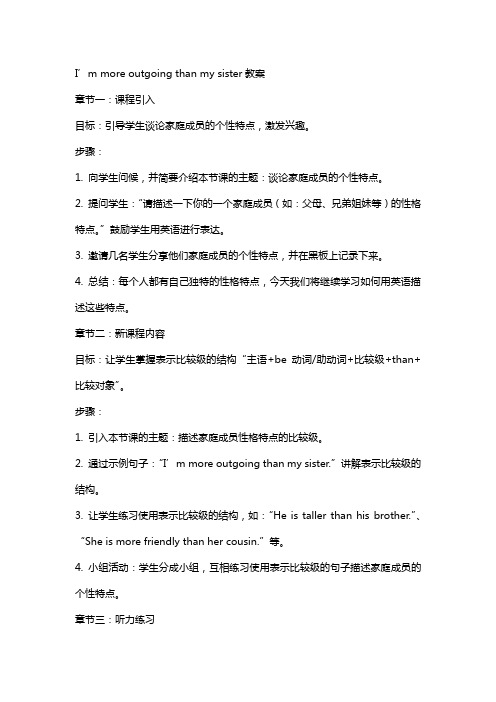
I’m more outgoing than my sister教案章节一:课程引入目标:引导学生谈论家庭成员的个性特点,激发兴趣。
步骤:1. 向学生问候,并简要介绍本节课的主题:谈论家庭成员的个性特点。
2. 提问学生:“请描述一下你的一个家庭成员(如:父母、兄弟姐妹等)的性格特点。
”鼓励学生用英语进行表达。
3. 邀请几名学生分享他们家庭成员的个性特点,并在黑板上记录下来。
4. 总结:每个人都有自己独特的性格特点,今天我们将继续学习如何用英语描述这些特点。
章节二:新课程内容目标:让学生掌握表示比较级的结构“主语+be动词/助动词+比较级+than+比较对象”。
步骤:1. 引入本节课的主题:描述家庭成员性格特点的比较级。
2. 通过示例句子:“I’m more outgoing than my sister.”讲解表示比较级的结构。
3. 让学生练习使用表示比较级的结构,如:“He is taller than his brother.”、“She is more friendly than her cousin.”等。
4. 小组活动:学生分成小组,互相练习使用表示比较级的句子描述家庭成员的个性特点。
章节三:听力练习目标:提高学生听力理解能力,学会从听力材料中获取相关信息。
步骤:1. 播放一段听力材料,内容为两个同学在谈论他们的家庭成员。
2. 学生边听边做笔记,记录下关键词和信息。
3. 听完后,邀请学生简要复述听力内容,并回答相关问题。
4. 针对听力材料中的比较级句子进行提问,如:“According to the listening material, who is more outgoing between the two speakers?”章节四:口语练习目标:培养学生运用英语进行口语表达的能力。
步骤:1. 学生分成小组,每组选出一个家庭成员的个性特点进行讨论。
2. 要求学生在小组内用英语进行讨论,使用本节课学到的表示比较级的句子。
Unit 3 I’m more outgoing than my sister. 全单元教案(5课时)
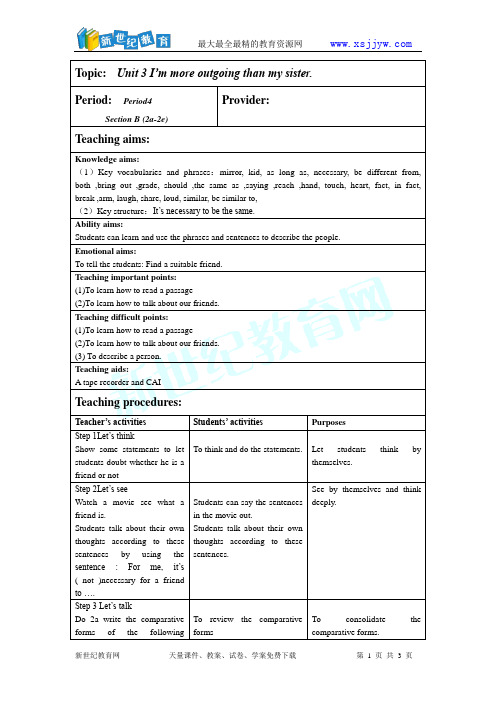
To consolidate the meaning of the passage and improve students’ speaking skill.
Step 6 Let’s compare
2.Which friend do you think about when you read this saying? Why?
3.Write a passage like this.
Describe their friends.
To improve Ss’ writing ability.
Homework
(2)Key structure:It’s necessary to be the same.
Ability aims:
Students can learn and use the phrases and sentences to describe the people.
Emotional aims:
Students can say the sentences in the movie out.
Students talk about their own thoughts according to these sentences.
See by themselves and think deeply.
To tell the students: Find a suitable friend.
Teaching important points:
(1)To learn how to read a passage
I’m more outgoing than my sister教案
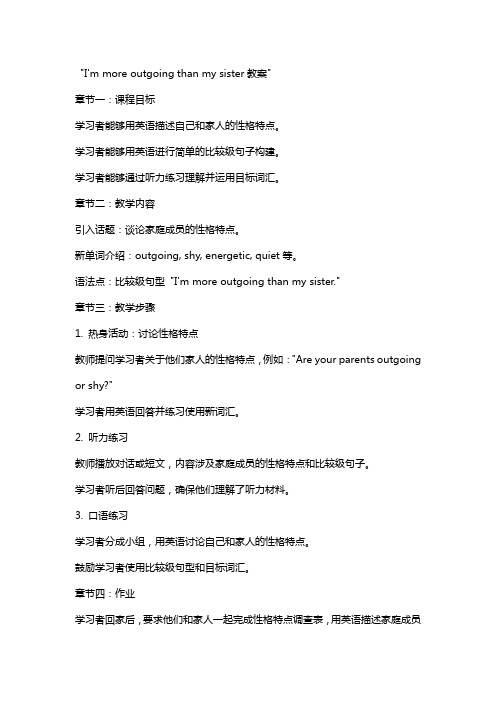
"I'm more outgoing than my sister教案"章节一:课程目标学习者能够用英语描述自己和家人的性格特点。
学习者能够用英语进行简单的比较级句子构建。
学习者能够通过听力练习理解并运用目标词汇。
章节二:教学内容引入话题:谈论家庭成员的性格特点。
新单词介绍:outgoing, shy, energetic, quiet等。
语法点:比较级句型"I'm more outgoing than my sister."章节三:教学步骤1. 热身活动:讨论性格特点教师提问学习者关于他们家人的性格特点,例如:"Are your parents outgoing or shy?"学习者用英语回答并练习使用新词汇。
2. 听力练习教师播放对话或短文,内容涉及家庭成员的性格特点和比较级句子。
学习者听后回答问题,确保他们理解了听力材料。
3. 口语练习学习者分成小组,用英语讨论自己和家人的性格特点。
鼓励学习者使用比较级句型和目标词汇。
章节四:作业学习者回家后,要求他们和家人一起完成性格特点调查表,用英语描述家庭成员的性格特点。
学习者需要将调查表拍照并发给教师以便进行评价。
章节五:评价教师根据学习者在课堂上的参与度、口语练习的表现以及作业的完成情况进行评价。
评价包括对学习者使用比较级句型和目标词汇的正确性以及他们的听说能力。
章节六:课程资源教学音频材料:包含家庭成员性格特点的对话或短文。
性格特点调查表:用于家庭成员性格特点的记录和描述。
教学PPT:展示新词汇和语法点。
章节七:教学注意事项确保学习者能够理解并正确使用比较级句型。
鼓励学习者积极参与课堂讨论和口语练习。
提供足够的听力练习材料,帮助学习者理解和运用目标词汇。
章节八:扩展活动组织一个小游戏,学习者通过角色扮演表演家庭成员的性格特点。
学习者分组,用英语编写一个关于家庭成员性格特点的故事,并进行分享。
人教版英语八年级上册Unit3I'mmoreoutgoingthanmysister.大单元教学设计

一、教学目标
(一)知识与技能
在本章节的学习中,学生将掌握并运用以下知识与技能:
1.能够理解并运用比较级的概念,描述人物外貌、性格、能力等方面的差异,如:“I'm more outgoing than my sister.”。
3.部分学生在听力方面存在困难,对日常对话的理解仍有待提高。
4.学生在合作学习过程中,沟通能力、团队协作能力有待加强。
5.部分学生对英语学习缺乏自信,课堂参与度不高。
针对以上学情,教师在教学过程中应关注以下几点:
1.通过生动有趣的课堂活动,激发学生的学习兴趣,提高他们的学习积极性。
2.注重基础知识的教学,帮助学生巩固比较级知识,提高语言表达能力。
4.词汇积累:
学生需要在本章节的基础上,自主查找5个与比较级相关的词汇,并写下它们的英文释义和例句。通过这样的词汇积累活动,学生可以扩大词汇量,提高语言运用能力。
5.自我反思:
学生需完成一份自我反思报告,内容包括对本章节学习过程中的优点和不足的认识,以及下一阶段的学习计划。这样的反思有助于学生形成自主学习意识,培养自我管理能力。
3.采用分层教学,针对不同水平的学生制定合适的教学任务,使每个学生都能在课堂上获得成就感。
4.加强听力训练,提高学生的听力水平,为日常交流打下基础。
5.注重培养学生的合作意识和沟通能力,使他们学会在团队中发挥自己的优势,共同完成任务。
6.关注学生的情感需求,鼓励他们积极参与课堂活动,增强自信心,提高英语学习效果。
c.写作练习:让学生编写一段关于自己和朋友的比较级描述,巩固所学知识。
(五)总结归纳
《八年级英语 I'm more outgoing than my sister.》教学设计
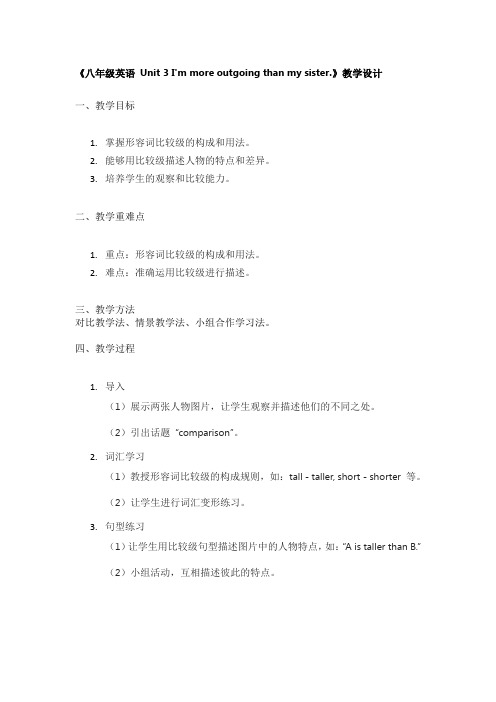
《八年级英语Unit3I'm more outgoing than my sister.》教学设计
一、教学目标
1.掌握形容词比较级的构成和用法。
2.能够用比较级描述人物的特点和差异。
3.培养学生的观察和比较能力。
二、教学重难点
1.重点:形容词比较级的构成和用法。
2.难点:准确运用比较级进行描述。
三、教学方法
对比教学法、情景教学法、小组合作学习法。
四、教学过程
1.导入
(1)展示两张人物图片,让学生观察并描述他们的不同之处。
(2)引出话题“comparison”。
2.词汇学习
(1)教授形容词比较级的构成规则,如:tall-taller,short-shorter等。
(2)让学生进行词汇变形练习。
3.句型练习
(1)让学生用比较级句型描述图片中的人物特点,如:“A is taller than B.”
(2)小组活动,互相描述彼此的特点。
4.听力训练
(1)播放课本听力材料,让学生完成听力任务。
(2)检查答案,讲解重点句型。
5.阅读教学
(1)学生阅读课本中的文章,理解比较级在文中的运用。
(2)提出问题,让学生回答,加深对文章的理解。
6.写作训练
(1)让学生写一篇短文,比较自己和朋友的不同之处。
(2)教师批改,反馈写作中的问题。
7.总结归纳
(1)总结形容词比较级的构成和用法。
(2)提醒学生注意比较级的特殊变化。
8.作业布置
(1)完成课后练习。
(2)用比较级描述自己的家庭成员。
Unit 3 I’m more outgoing than my sister全英教案(五课时)
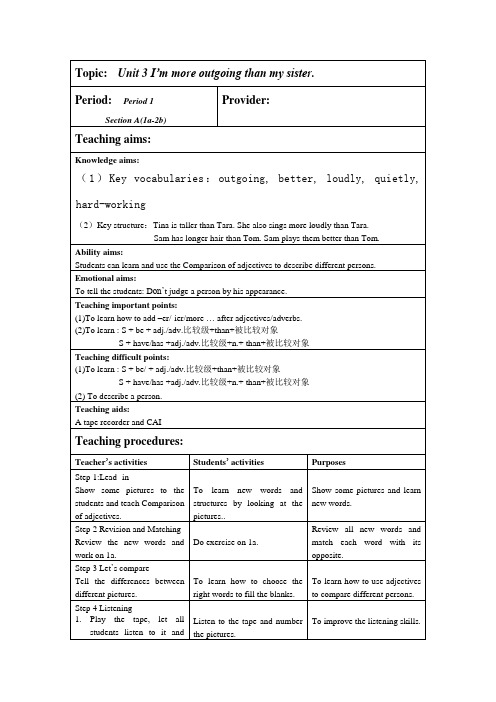
Watch a movie.
To make the class more active andTo improve Ss’speaking ability. Ss can enjoy it.
Step 3 Let’s talk
Ask Ss to look at3cand compare their parents.
Work on3c.
To improep 4 Role-play conversation
(1)Play the tape and ask the Ss to listen to theconversation.Ask two questions:
What are they talking about?
hard-working more hard-workingA: Is Tom … than Sam?B: …
A: Is Sam … than Tom? B: …
Topic:Unit 3I’m more outgoing than my sister.
Period:Period2
Section A(2c-3b)
Step 8 Let’s say
Ask the students to look at the box. Compare the same and different between Lily and Tom.
Describe the same and different between Lily and Tom.
A: Is Sam … than Tom? B: …
To improve Ss’speaking ability.
Unit 3 I’m more outgoing than my sister教案
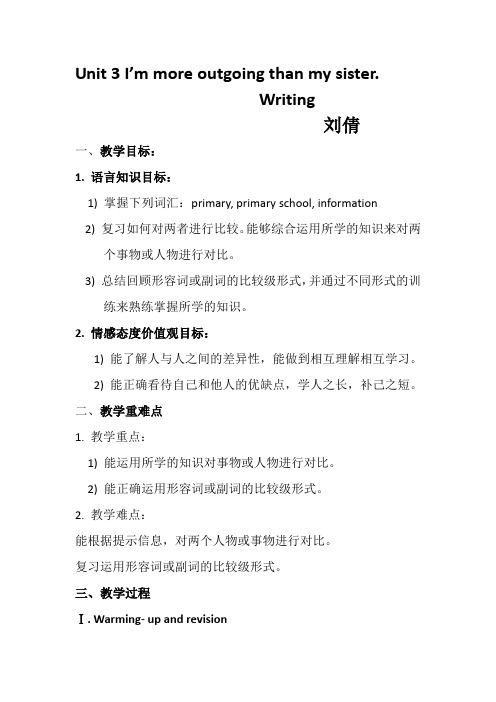
Unit 3 I’m more outgoing than my sister.Writing刘倩一、教学目标:1. 语言知识目标:1) 掌握下列词汇:primary, primary school, information2) 复习如何对两者进行比较。
能够综合运用所学的知识来对两个事物或人物进行对比。
3) 总结回顾形容词或副词的比较级形式,并通过不同形式的训练来熟练掌握所学的知识。
2. 情感态度价值观目标:1) 能了解人与人之间的差异性,能做到相互理解相互学习。
2) 能正确看待自己和他人的优缺点,学人之长,补己之短。
二、教学重难点1. 教学重点:1) 能运用所学的知识对事物或人物进行对比。
2) 能正确运用形容词或副词的比较级形式。
2. 教学难点:能根据提示信息,对两个人物或事物进行对比。
复习运用形容词或副词的比较级形式。
三、教学过程Ⅰ. Warming- up and revision1. Have a dictation of the new words and expressions.2. Let some Ss read their passages to the class.3. Ask some Ss to compare themselves and their friends.Ⅱ. Presentation1. Show some pictures of the students of your class. Describe the Ss. She is tall/short. She is popular/serious/hardworking. → be + 形容词She has long straight hair/ short straight hair. → have/has …hair She likes reading/sports…→likes…2. Let some Ss describe the student in the big screen.Ⅲ. WritingWork on 3b:1. Think of your friends. Make notes about two of your friends. One friend should be similar to you. The other friend should be different.2. Give some examples: popular, outgoing, serious, hard-working, tall, thin … likes reading/sports, art, music… has long/short straight hair …3. 以“My friends and I”题,写一篇不少于70 词的文章。
Unit 3 I’m more outgoing than my sister. 全单元教案
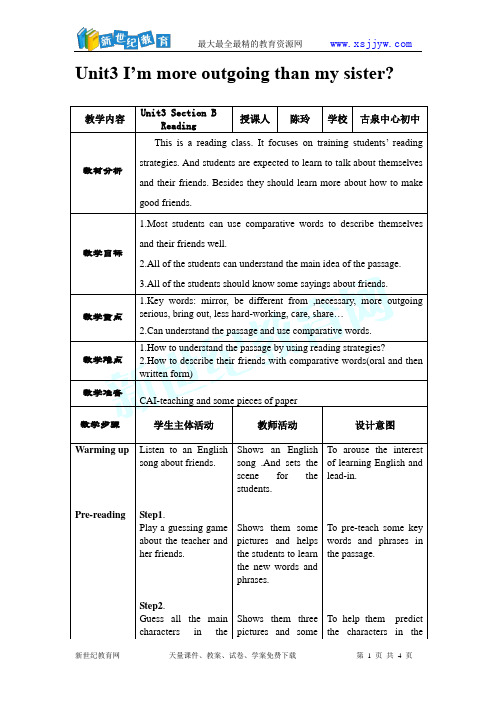
教学难点
1.How to understand the passage by using reading strategies?
2.How to describe their friends with comparative words(oral and then written form)
Shows their tasks and helps them to scan.
Helps them present their different answers and share with each other.
1.Shows them the comparative words on the screen.
Good friends are…
●Thenpresent their discussion results on the blackboard in groups.
Step2.
Summarize the class.
Shows an English song .And sets the scene for the students.
Play a guessing game about the teacher and her friends.
Step2.
Guess all the main characters in the reading.
Step1.
Skim for the main idea.
Step2.
●Scan and finish the tasks in their own groups
unit3-i'm-more-outgoing-than-my-sister.教案
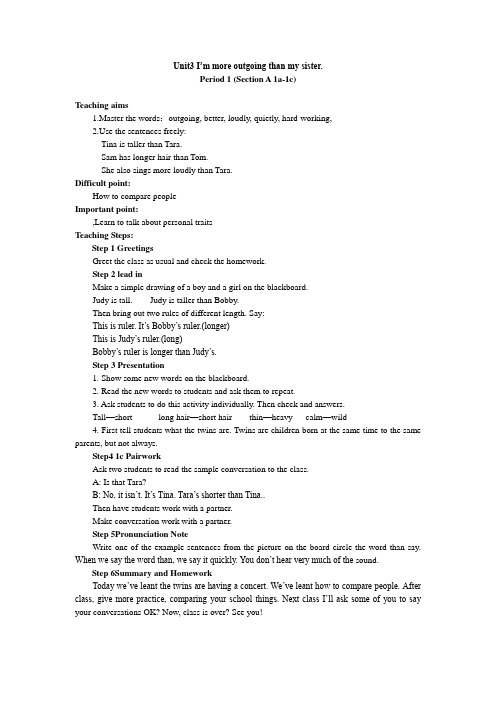
Unit3 I’m more outgoing than my sister.Period 1 (Section A 1a-1c)Teaching aims1.Master the words:outgoing, better, loudly, quietly, hard-working,e the sentences freely:Tina is taller than Tara.Sam has longer hair than Tom.She also sings more loudly than Tara.Difficult point:How to compare peopleImportant point:,Learn to talk about personal traitsTeaching Steps:Step 1 GreetingsGreet the class as usual and check the homework.Step 2 lead inMake a simple drawing of a boy and a girl on the blackboard.Judy is tall. Judy is taller than Bobby.Then bring out two rules of different length. Say:This is ruler. It’s Bobby’s ruler.(longer)This is Judy’s ruler.(long)Bobby’s ruler is longer than Judy’s.Step 3 Presentation1. Show some new words on the blackboard.2. Read the new words to students and ask them to repeat.3. Ask students to do this activity individually. Then check and answers.Tall—short long hair—short hair thin—heavy calm—wild4. First tell students what the twins are. Twins are children born at the same time to the same parents, but not always.Step4 1c PairworkAsk two students to read the sample conversation to the class.A: Is that Tara?B: No, it isn’t. It’s Tina. Tara’s shorter than Tina..Then have students work with a partner.Make conversation work with a partner.Step 5Pronunciation NoteWrite one of the example sentences from the picture on the board circle the word than say. When we say the word than, we say it quickly. You don’t hear very much of the sound.Step 6Summary and HomeworkToday we’ve leant the twins are having a concert. We’ve leant how to compare people. After class, give more practice, comparing your school things. Next class I’ll ask some of you to say your conversations OK? Now, class is over? See you!。
- 1、下载文档前请自行甄别文档内容的完整性,平台不提供额外的编辑、内容补充、找答案等附加服务。
- 2、"仅部分预览"的文档,不可在线预览部分如存在完整性等问题,可反馈申请退款(可完整预览的文档不适用该条件!)。
- 3、如文档侵犯您的权益,请联系客服反馈,我们会尽快为您处理(人工客服工作时间:9:00-18:30)。
Unit 3 I’m more outgoing than my sister.Period 1 (Section A 1a-1c)Teaching Aims:1. Words: outgoing; better: loudly; quietly; hard-working; competition.Language objectives:That’s Tara, isn’t it?Sam has longer hair than Tom .Both Sam and Tom can play the drums, but Sam plays them better than Tom.Tara works as hard as Tina.2.Ability objectives:to talk about personal traits and compare people; to improve Ss’ speaking,listening and writing skills.to grasp the structure of comparatives, e.g. comparatives with –(i)er and more,both and as...as...; to grasp the structure: A+谓语+比较级(adj./adv.)+than+B, A+谓语+as+原级(adj./adv.)+as+B; to recycle vocabulary about description3. Emotional objectives: to find strengths of somebody else, to explore the beautyof the world.Important and difficult points:1. To talk about personal traits特点; to grasp how to compare people.2. To use target language: A+谓语+比较级(adj./adv.)+than+B, A+谓语+as+原级(adj./adv.)+as+B, comparatives with –(i)er and more.3. To improve Ss’listening, speaking and writing skills; to develop theircommunicative competence.Teaching Procedures:Step 1 Leading-in.To show some pictures to recycle adj. based on some types, and learn some new words.Step 2 1a1 Learn new words:outgoing,better loudly quietly which competition fantastichard-workingclearly win funny friendly smart lazylook at the picture in 1a and make a lis t of the adjectives.Purpose: to make Ss recall some adjectives they have learnt before;Step 3 Presentation1. . To ask Ss the usage of the adj. and show some example sentences aboutcomparative degree.2. To show some adjectives and adverbs with –(i) er, -r, more and some specialwords likebetter, more, worse, etc.. Then ask Ss to discuss the common points of the words.Purpose: to lead in comparative degree; to make Ss summarize the change rules of comparative degree of adj.and adv..1.To make Ss compare two persons or two things with the above adjectives andadverbs; to summarize the pattern of comparative degree.“A+谓语+比较级(adj./adv.)+than+B”2.To show the map of Liaoning Province to guide Ss to compare Chaoyang andDalian in size, climate, slight spots and so on; to show the pictures ofChaoyang fossil to let Ss know Chaoyang is a place where the first flowercomes out.Purpose: to practice comparatives; to show the structure of “A+谓语+as+原级(adj./adv.)+as+B” and complete emotional aims.Step 4.1b listen and write the number of the pairs.Listen again for the students to listen and fill in the chart.Check the answers with the classStep 5 Practice.1. Pair work:Compare two persons.Purpose: to make Ss practice the patterns of comparative degree.Step 6 To sum up.1.To make the Ss summarize what they have learnt in this class.2.Guessing game.;Step 7 Homework.1.Preview 2d2.Writing: The person I respect.Blackboard design:Unit 3 I’m more outgoing than my sister.Section A 1a-1c1.Key words:-(i) er, more-both, as...as...2.Patterns:A+谓语+比较级(adj./adv.)+ than + BA+谓语+as+原级(adj./adv.)+ as + BPeriod 3 (Section A 2a-2d) Teaching Aims:1)Key vocabularies: competition, fantastic, which, clearly, win, though(2)Key structure:Is Tom smarter than Sam. No, he isn’t . He is smarter than Tom.Which one was Lisa? The one with shorter hair.Who is more hard-working at school?Ability aims:Students can use the Comparison of adjectives to compare different persons. Emotional aims:Everyone may has own opinion, different people have different ideas.Teaching important points:(1)To learn how to add –er/-ier/more … after adjectives/adverbs.(2)To learn : S + be + adj./adv.比较级+than+被比较对象S + have/has +adj./adv.比较级+n.+ than+被比较对象(3)To learn: Who+be+adj. 比较级+…?Teaching difficult points:(1)To learn Which/who sentences.Ss can understand and write a short passage between two persons..Teaching procedures:Step 1 Enjoying a movie1.Play a movie and fill in the blanks.2.Review: A +谓语+ as +原级(adj./adv.)+ as +B.3. add –er/-ier/more … after adjectives/adverbs.Step 2 Presentation.Show the pictures, and add –er/-ier/more … after adjectives/adverbs.Then use“B is (not) +as +adj/adv原级+as A.”Step 3: 2a 2b Listening1.Listen and change the adjectives into comparatives by -er/ier/or more.2. Listen again and say:3.How are Tina and tara different ?3. Pay attention to: more outgoing,as...as...Step 4: 2c Pair work:Fill in the chart first and then make conversations in pairs.Step 5: 2d Role-play the conversationsLet the students read the chart and find out the differences between Sam and Tom.Explain the comparatives of the adje ctives1) smart-smarter 2) funny-funnier 3) hardworking-more hardworking3.Let the s tudents h ave five minutes for the students to recite the statements.4.Role-play the conversation in pa irs.Step 6 To sum up.3.To make the Ss summarize what they have learnt in this class.4.Guessing game.;Step 7 Homework.Period 3 (Section A 3a-3c)Teaching Aims:Key structure:Is Tom smarter than Sam?Is Tina more outgoing tha n Tina?Are you as friendly as your sister?Does Tina work as hard as Tara?Who’s more hard-working at school?Ability aims:Students can use the Comparison of adjectives to compare different persons. Emotional aims:Everyone may has own opinion, different people have different ideas.Teaching important points:(1)To learn how to add –er/-ier/more … after adjectives/adverbs.(2)To learn : S + be + adj./adv.比较级+than+被比较对象S + have/has +adj./adv.比较级+n.+ than+被比较对象(4)To learn: Who+be+adj. 比较级+…?Teaching difficult points:(2)To learn Which/who sentences.Ss can understand and write a short passage between two persons.Teaching procedures:Step1 Revision 2,写出下面形容词的比较级形式white young funnyred west cloudygreen windy happyblue curly busyyellow straight sorrybig tall scarysmall hot warmshort cold strictlong cool cheapfantastic colorful successful unfriendly tireddelicious relaxed international expensive sunnyStep 2 Grammar FocusLet the students read the sentences in the box and make sure they understand them. Pay attention to the use of the following sentences:Is Tom smarter than Sam?Is Tina more outgoing tha n Tina?Are you as friendly as your sister?Does Tina work as hard as Tara?Who’s more hard-working at school?要点总结形容词在句中常作表语和定语,也可补充说明宾语;副词的句中主要作状语。
